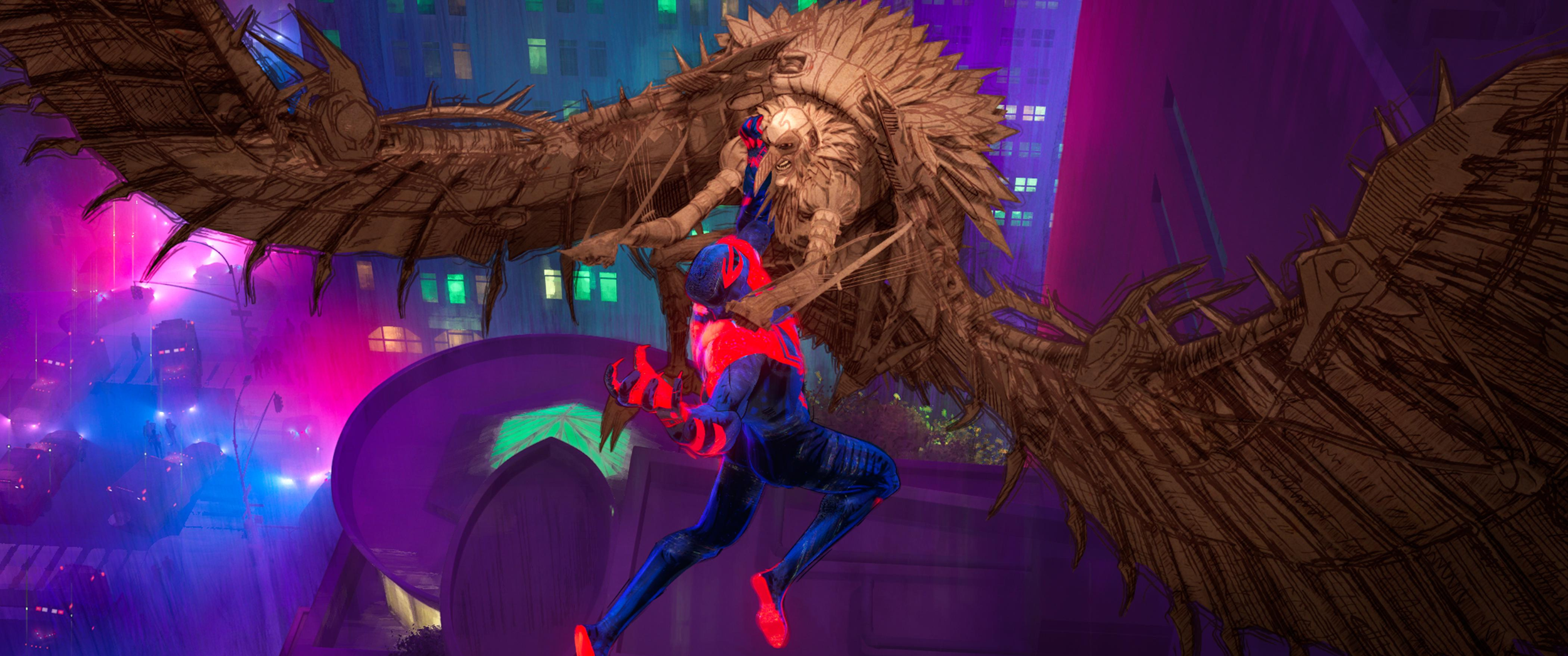‘Spider-Man: Across The Spider-Verse’ Review: Fragmented Story Stops The Sequel From Being Great
Miles Morales (Shameik Moore) and Gwen Stacy (Hailee Steinfeld) take on The Spot (Jason Schwartzman) in Columbia Pictures and Sony Pictures Animation's SPIDER-MAN™: ACROSS THE SPIDER-VERSE. Sony Pictures Animation ©2022 CTMG, Inc. All Rights Reserved.
Okay, let’s do this one (not the last) last time. In 2018, Spider-Man: Into the Spider-Verse was released in theaters, and it changed the medium of animation for modern cinema as we know it. Whether it was the breathtakingly inventive visual style that showed what a comic book movie truly could be or the strong emotional core behind the film, or even the way it acknowledged past Spider-Man films and their clichés, it’s safe to say that for many, the film was nothing short of a masterpiece. Unfortunately, Spider-Man: Across the Spider-Verse isn’t a masterpiece, and it doesn’t come very close to earning that title. Across the Spider-Verse picks up roughly one year after the events of Into the Spider-Verse and follows Miles Morales (Shameik Moore) as he’s adapting to the new responsibilities and difficulties that come with being the one-and-only Spider-Man. We meet Miles, now a more developed hero, as he’s stopping a robbery. Unfortunately for him, this isn’t a two-bit villain-of-the-week robber but an emerging supervillain who claims to be Miles’ true nemesis: The Spot (voiced by Jason Schwartzman). When Spot’s intentions turn toward a Spider-Verse-threatening amount of amassed power, he attracts the attention of the Spider Society, led by Spider-Man 2099 (Oscar Isaac) and Spider-Woman (Issa Rae), plus her trainee, Gwen Stacy (Hailee Steinfeld).
Ben Reilly in Columbia Pictures and Sony Pictures Animation's SPIDER-MAN™: ACROSS THE SPIDER-VERSE. Sony Pictures Animation ©2022 CTMG, Inc. All Rights Reserved.
Arguably the most prominent discussion point surrounding the 2018 film was the way the film was animated and how good it looked. Thankfully, that remains true for the second film, as the animators up their workload, featuring numerous distinct art styles for each universe, with many still relaying the comic-book nature of the film, even though they push the boundaries of the animation to a place that could never be achieved on the page. Though the idea of different art styles for each universe sounds good on paper, there’s somewhat of a blend in certain cases that don’t add anything visually and makes the concept seem like more of a gimmick than anything else (like I said, still pretty most of the time). This may feel nitpicky — aside from the fact that there doesn’t seem to be a given set of guidelines and rules for how this works. For some characters, their animation style changes to adapt to the universe they’re in, while other characters look the same no matter what. And even after that, it’s not as if every universe has distinct visual differences, with multiple worlds looking nearly identical in their style. There’s no question that the animation is stunning — truly a visual work of art. It’s just lacking when it comes to the planning and inner workings of how it works.
The biggest issue with Across the Spider-Verse is that, quite frankly, it’s the second film in a trilogy, and it shows. Narratively, the film’s entire plot feels like the setup for something larger, because it is. Unfortunately, the film’s narrative is weak to the point that it becomes distracting towards the end of the film, as it feels like not much has happened. Most of the story presented feels like filler and fan service aimed to generate excitement for Beyond the Spider-Verse, which (tentatively) releases next March. Luckily for Across the Spider-Verse (and to the filmmakers’ credit), the film is paced so briskly that it doesn’t force you to dwell on its story but directs your attention to what’s currently happening on screen. That’s not to say that there aren’t slower moments in the film because there are plenty of them, and they make up some of the strongest moments in the runtime. One thing that eases us through the film as a whole is Daniel Pemberton’s score, which was the silent MVP of the first time and rises into the spotlight here, aided by original music from Metro Boomin. Pemberton combines unconventional items with what we’d expect from a score, resulting in music that harmonizes with what’s happening on screen for a fantastic outcome.
Miguel O’Hara (Oscar Isaac) clashes with Vulture (Jorma Taccone) in Columbia Pictures and Sony Pictures Animation's SPIDER-MAN™: ACROSS THE SPIDER-VERSE. Sony Pictures Animation ©2022 CTMG, Inc. All Rights Reserved.
If Into the Spider-Verse was an homage to the Spider-Man content that came before it, Across the Spider-Verse is a full-blown series of love letters to all things related to the web-slinger. Whether it’s the sheer amount of Spider-People or Spider-Man-related easter eggs, the film clearly has a deep appreciation and love for its characters and goes to all lengths to show it off. That said, most of the ways that the film approaches this is through traditional “fan service” that, while it will have fans excitedly pointing at the screen and whispering to the person next to them, doesn’t always add to the narrative and overcomplicates the film’s moving parts. More time is spent on thinking of ways to create easter eggs to or directly reference the past Spider-Man films and Spider-Man moments in pop culture, making those moments our main focus at times, distracting from the narrative that fails to stand strong as a standalone feature. Given the bombardment of characters and cameos, it’s hard for certain characters to stand out, but the rebellious Spider-Punk (Daniel Kaluuya) is by far the one to take the spotlight out of the new additions, though, from an acting perspective, Oscar Isaac’s Spider-Man 2099 shines the most. For the returning characters, it’s Hailee Steinfeld’s Spider-Gwen that stands out, promoted from a supporting character to essentially a co-lead. Though this is undoubtedly still Miles’ story, Gwen is given her own arc, complete with a fleshed-out backstory and strong motivation for her actions over the film’s course.
Spider-Gwen (Hailee Steinfeld) and Miles Morales as Spider-Man (Shameik Moore) in Columbia Pictures and Sony Pictures Animation’s SPIDER-MAN: ACROSS THE SPIDER-VERSE. Sony Pictures Animation ©2022 CTMG, Inc. All Rights Reserved.
To be fair, since its announcement, Across the Spider-Verse was billed as part one of a two-part story. During an interview with GamesRadar, co-director Kemp Powers announced that the film would have a cliffhanger ending, one akin to that of The Empire Strikes Back’s reveal of Luke’s heritage. This cliffhanger was a piece of information that I didn’t know going into the movie, and yet, the third-act twists Across the Spider-Verse attempts are seen coming from miles away as the film takes its time to reveal information that can be picked up on nearly a half hour before they want us to comprehend it. To the film’s credit, Spider-Verse’s pacing is incredibly electric, turning a two-hour and sixteen-minute runtime into one that feels much shorter, aside from its final sequences, which slow things down to the uncomfortable, predictable burn before ending the film at the wrong place in a specific scene. Even though it has such a large cast with strong talents, aside from a few moments, most of the performances are extremely one-note, unable to differentiate moments of quiet intimacy from the large-scale battles that have become a staple of the genre.
Like Into the Spider-Verse, there is clear emotional reasoning behind many of the characters’ actions in the film, but it gets sidelined because, apparently, we need more massive fights that resolve themselves in some of the most mind-boggling ways imaginable. It saves all possible forms of emotional resolution and (a surprisingly well set up) payoff for the third film in the trilogy, which is given the potential to be the strongest of all three, thanks to what Across the Spider-Verse does in building stakes and emotions, though it leaves most of them up in the air (hence the incomplete nature of the narrative). In all fairness, Across the Spider-Verse blows most recent superhero projects out of the water and is by far the strongest Spider-Man property since Into came out five years ago. When it comes to whether or not it’s worth seeing Across the Spider-Verse, it comes down to the question of whether or not you’re a fan of the character because, for those who are, the movie is likely to be nothing less than a grand slam, even if it may not be perfect. ∎ This Week Media
Spider-Man: Across the Spider-Verse swings into theaters worldwide on June 2.
This review was made possible thanks to Sony Pictures who invited us to a preview screening of Spider-Man: Across the Spider-Verse for review purposes.




